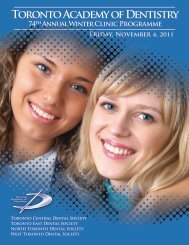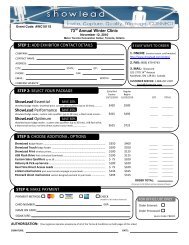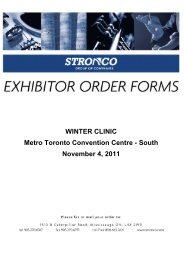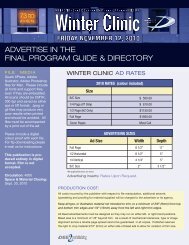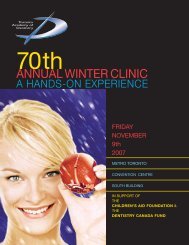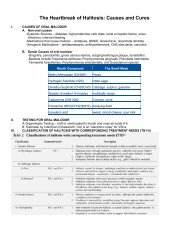Clinicians at the 72nd Annual Winter Clinic - Toronto Academy of ...
Clinicians at the 72nd Annual Winter Clinic - Toronto Academy of ...
Clinicians at the 72nd Annual Winter Clinic - Toronto Academy of ...
You also want an ePaper? Increase the reach of your titles
YUMPU automatically turns print PDFs into web optimized ePapers that Google loves.
Of Interest to: Dentists Dental Hygienists <strong>Clinic</strong>al Assistants Administr<strong>at</strong>ive Assistants Dental Technologists<br />
<strong><strong>Clinic</strong>ians</strong> <strong>at</strong> <strong>the</strong> <strong>72nd</strong> <strong>Annual</strong> <strong>Winter</strong> <strong>Clinic</strong><br />
8:45 a.m. – 11:30 a.m.<br />
Room 718B<br />
Chair: Dr. Sheryl Lipton<br />
Posterior Composite Resins<br />
in 2009<br />
1:30 p.m. - 3:30 p.m.<br />
Room 718B<br />
Chair: Dr. Mike Bulger<br />
Technique Technique<br />
Technique<br />
John C. McManama, DDS<br />
Boston University, Goldman School <strong>of</strong> Dental Medicine<br />
About <strong>the</strong> Speaker<br />
Dr. John McManama is a pr<strong>of</strong>essor in <strong>the</strong> Department <strong>of</strong> General<br />
Dentistry <strong>at</strong> Boston University, Goldman School <strong>of</strong> Dental Medicine<br />
where he has received numerous awards and honors. He is <strong>the</strong> Director<br />
<strong>of</strong> Programs and Courses <strong>at</strong> every level <strong>of</strong> <strong>the</strong> dental school and also<br />
served as Chairman <strong>of</strong> <strong>the</strong> Department <strong>of</strong> Oper<strong>at</strong>ive Dentistry. He is a<br />
highly regarded intern<strong>at</strong>ional speaker having presented numerous programs<br />
around <strong>the</strong> world on all areas <strong>of</strong> restor<strong>at</strong>ive dentistry with an<br />
emphasis on conserv<strong>at</strong>ive adhesive dentistry. Dr. McNanama also maintains<br />
a general practice with <strong>the</strong> Restor<strong>at</strong>ive Dental Group <strong>of</strong> Cambridge.<br />
About <strong>the</strong> Program<br />
This course is intended to take a critical look <strong>at</strong> posterior resin based composite<br />
restor<strong>at</strong>ions in 2009. The discussion will clarify and answer your<br />
questions regarding <strong>the</strong> present use <strong>of</strong> composite resin and address <strong>the</strong><br />
issue <strong>of</strong> whe<strong>the</strong>r it has evolved to <strong>the</strong> point where composite resin is really<br />
ready to replace amalgam and wh<strong>at</strong> <strong>the</strong> future holds.<br />
You will learn<br />
● Diagnose and tre<strong>at</strong> incipient lesions<br />
● Isol<strong>at</strong>ion techniques<br />
● Minimally invasive prepar<strong>at</strong>ion design<br />
● Deep lesions and pulp capping<br />
● Adhesive systems<br />
● M<strong>at</strong>rix systems<br />
● Flowable resins<br />
● Placement and curing techniques<br />
● Finishing and polishing<br />
● Tre<strong>at</strong>ment planning – when not to use composite resin<br />
About <strong>the</strong> Program<br />
As restor<strong>at</strong>ive m<strong>at</strong>erials continue to evolve, how can we practice evidence<br />
based dentistry when <strong>the</strong>re doesn’t seem to be a lot <strong>of</strong> evidence out<br />
<strong>the</strong>re This course will focus on two issues: selecting <strong>the</strong> best m<strong>at</strong>erials<br />
and using <strong>the</strong>m properly.<br />
You will learn<br />
● How do PFM crowns, zirconium and pressed ceramics compare to cast<br />
gold<br />
● Restor<strong>at</strong>ion <strong>of</strong> endodontically tre<strong>at</strong>ed teeth – when and how to use<br />
posts<br />
● Ceramic inlays and onlays – indic<strong>at</strong>ions and techniques<br />
● Veneers – ultra thin vs conventional<br />
● Retraction and Impression techniques<br />
● Luting agents and cement<strong>at</strong>ion techniques<br />
● Bite registr<strong>at</strong>ions<br />
● Post restor<strong>at</strong>ive sensitivity and its prevention<br />
● Tre<strong>at</strong>ing deep carious lesions<br />
● Cervical sensitivity and how to tre<strong>at</strong> it<br />
Who should <strong>at</strong>tend this program<br />
Recommending and providing care to our p<strong>at</strong>ients requires a solid understanding<br />
<strong>of</strong> <strong>the</strong> multitude <strong>of</strong> m<strong>at</strong>erials and techniques th<strong>at</strong> continue to<br />
evolve. All dentists, restor<strong>at</strong>ive dental hygienists and clinical assistants<br />
engaged in <strong>the</strong> restor<strong>at</strong>ion <strong>of</strong> teeth will find this program thought provoking<br />
and engaging .<br />
Who should <strong>at</strong>tend this program<br />
Composite resins should only be considered when you know th<strong>at</strong> you can<br />
predictably do <strong>the</strong>m well. An understanding <strong>of</strong> m<strong>at</strong>erial properties, technique<br />
and a recognition <strong>of</strong> its limit<strong>at</strong>ions is required. This program will be<br />
highly regarded by all restor<strong>at</strong>ive dentists, restor<strong>at</strong>ive dental hygienists<br />
and clinical assistants.<br />
w w w . t o r d e n t . c o m 29




